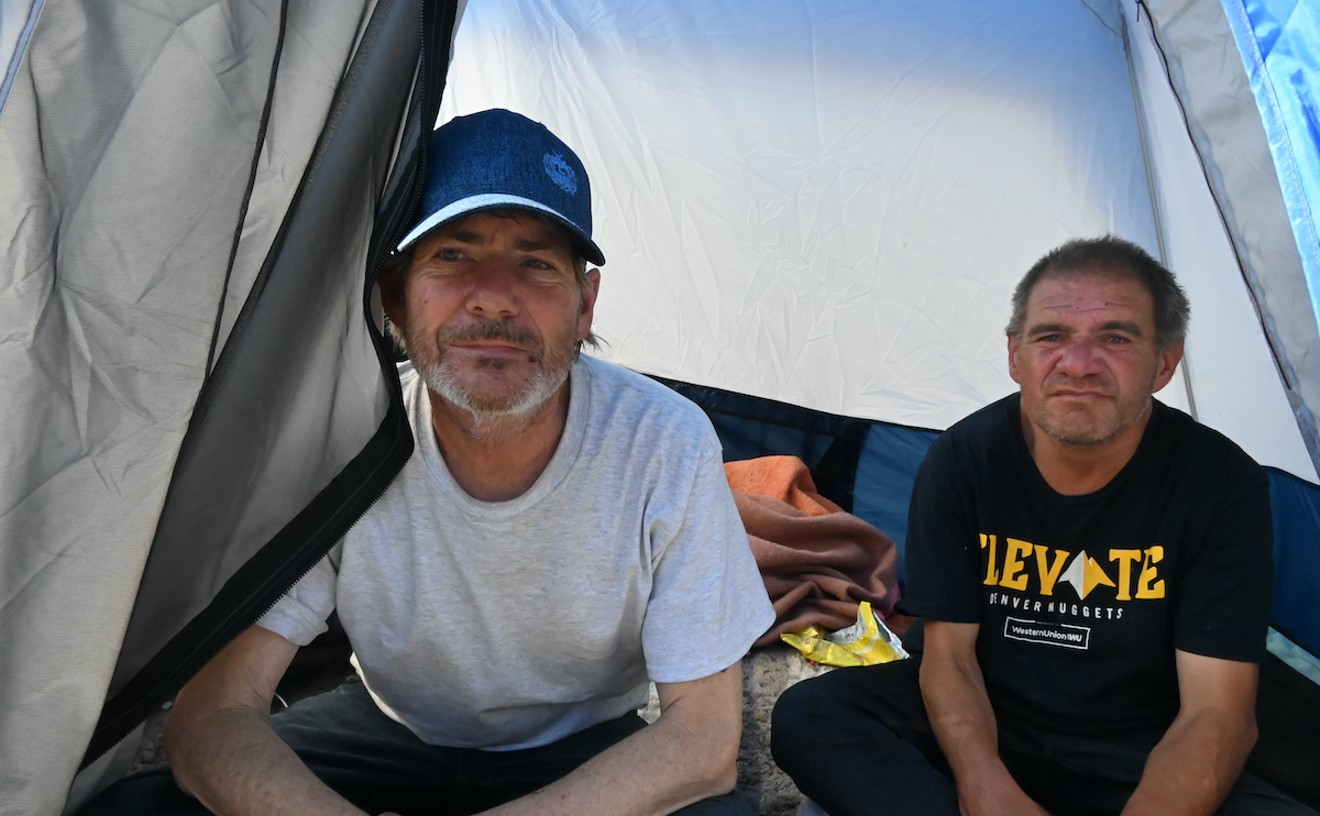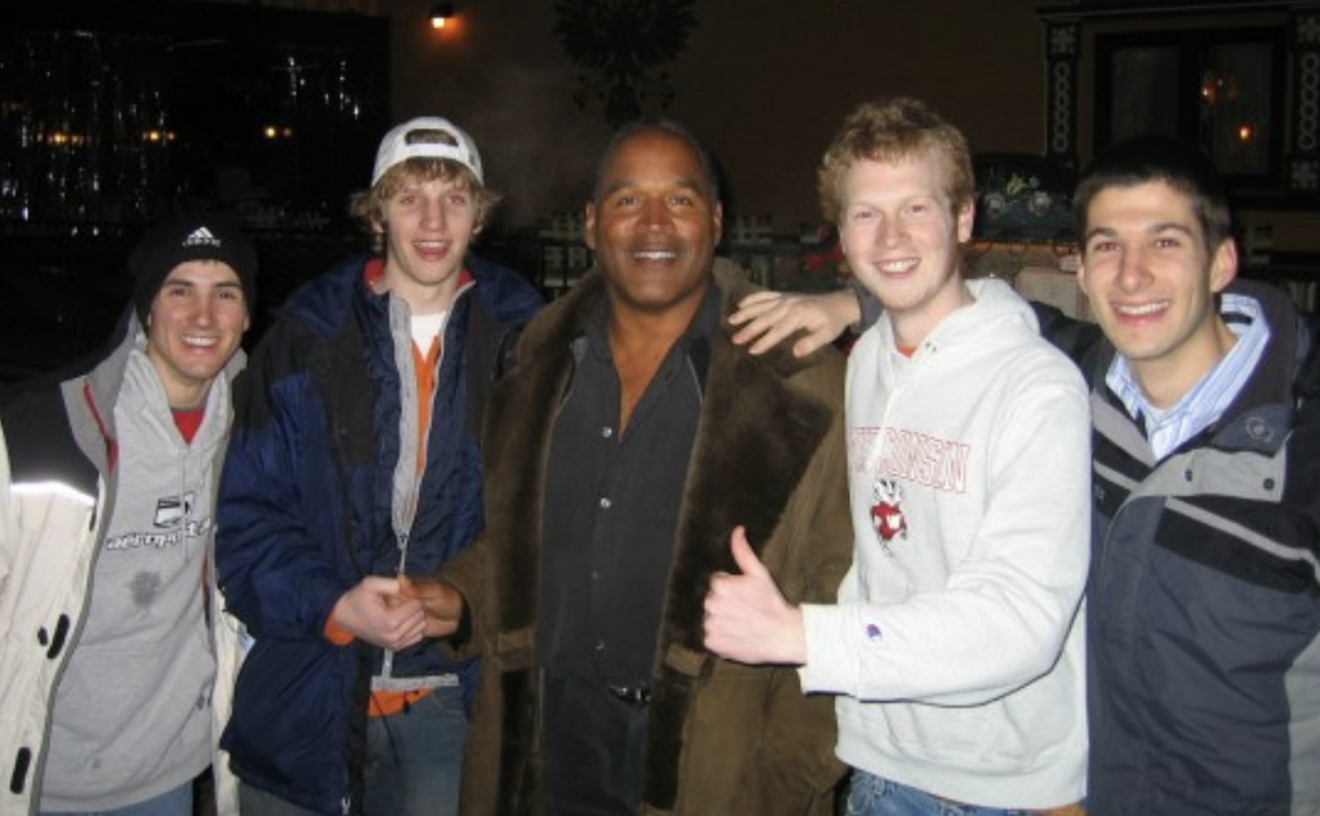Denver's ballots were mailed out to all registered voters ten days ago. The issues Denverites will decide include a housekeeping measure — should a Denver department change its name? — and the election of school-board members. But the real heavy lifting involves a huge bond measure proposed by the city, as well as one initiative proposed by residents. Here's our coverage of those issues, compiled into one piece.
On November 7 — or now, if you vote by mail-in ballot — Denver residents will decide if they want to approve nearly a billion dollars’ worth of bond measures, the heftiest general obligation bond proposal in the city’s history.
The GO Bond package, billed as “a plan to repair and improve Denver’s infrastructure,” is broken up into seven categories, labeled 2A through 2G: transportation and mobility systems; cultural facilities, which include the city’s biggest museums, the Denver Botanic Gardens, the Denver Zoo and the Denver Center for the Performing Arts; Denver Health, which would get a $75,000,000 outpatient ambulatory center; the public-safety system, which would improve and replace some police headquarters and fire stations; libraries; parks and recreation; and the public facilities system. They are listed individually on the ballot, so that voters can pick and choose.
Denver started using bonds in the 1940s to pay for projects like airports, hospitals, recreational facilities and public libraries. In the nearly seventy years that the city has taken bond measures before voters, only one proposal — a $325,000,000 justice-center bid in 2001 — was rejected. The last bond project, the $549,730,000 Better Denver Bond Program, passed in 2007. Some projects are still in the works. (You can track their progress at denver.org.)
The GO Bond’s boosters have touted the fact that approving the measure won’t raise property-tax rates; the city has seen an increase in property values, which allows for the new debt of $937 million without triggering an increase to tax rates, says Courtney Law, communications director at the Department of Finance.
After numerous committees submitted their wish lists, Denver City Council unanimously approved the final GO Bond project that’s on the ballot. There is no formal campaign against it, and the Denver Elections Division reports receiving just a handful of complaints from residents. Meanwhile, Our Denver, the formal campaign for the GO Bond, raised $2,191,428.72 through October 5 and is filling the airwaves and mailboxes with advertisements hyping the GO Bond components. “We need ’em all,” says Mayor Michael Hancock in a TV ad.
But while the bond proposal is supposed to be forward-thinking, many projects would address problems created by recent history, such as Denver’s exploding population over the past ten years and the opioid crisis. The whole package also raises philosophical questions about Denver’s future and how, exactly, we’ll get there, down to the dollar.
To see where Denver might be headed, we examined some of the projects included in the GO Bond. We'll roll out our stories about the Bond all week. Here, we examine 2A and 2B.
2A: Is the Transportation Bond Enough?
Nearly half of the total bond package, $431 million, is earmarked for transportation projects, including bridge repairs, expanded bike lanes, 33 miles of new sidewalks and a $55 million bus rapid transit (BRT) system on East Colfax Avenue. Question 2A is an essential component of Mayor Hancock’s mobility action plan (MAP), which aims to provide better and safer options for getting around Denver’s increasingly congested streets.
The need for pedestrian improvements and a more coherent bike network is clear; Denver spends far less than more progressive cities on such amenities, and Denver City Council recently rejected an effort to boost the annual spending on bike lanes by a mere $1 million. (At the current rate of spending, around $2.5 million a year, Denver won’t complete its bike network until 2040 or so.) But critics of 2A say that using long-term bond debt to deal with crumbling infrastructure and other maintenance issues is a bad idea.
There are plenty of other unknowns in what 2A proposes. Will a BRT on Colfax draw enough new transit riders to make it worth giving up two lanes of auto traffic? Does Denver have any business getting involved in overseeing a new transit project — basically shifting the cost of the BRT from the Regional Transportation District’s budget to the shoulders of property owners? Will increasing bike lanes and prioritizing transit operations lure people from their cars — Denver, at present, has one of the highest rates in the nation of people driving alone to work — or just make congestion worse?
Even if 2A passes, the Hancock administration will still be casting about for the funds to implement the complete MAP, which carries a price tag of $2 billion, to be spent over the next twelve years. At least $365 million of that total has no funding identified yet. — Alan Prendergast
2B: Should a City Fund Its Art Museums?
On a warm fall day, the lawn in front of the Denver Art Museum is full of schoolchildren on field trips. They sit quietly or play tag; you need to part a sea of them to get to the museum’s North Building.
When the Denver Art Museum started admitting children for free in 2015, school-group visits doubled in that year alone. Now 500 to 600 children visit daily — which has created nothing short of a logistical nightmare. Without a proper pick-up and drop-off point, school buses have turned the busy stretch in front of the North Building — West 14th Avenue between Bannock Street and Broadway — into a bus lane. That’s just one of the problems that museum officials hope to address with bond money.
Should the cultural-facilities portion of GO pass, Red Rocks and every “tier-one” cultural organization in town will get money for improvements and additions. But detractors of the cultural bond bring up a question frequently asked of tier-one facilities: Why do they get the lion’s share of the city’s money and attention while smaller museums and theaters go virtually ignored?
Designed by famed Italian architect Gio Ponti, the Denver Art Museum’s North Building is lauded for its intricate geometrical details and its status as one of the first high-rise museums. While the 210,000-square-foot building is notable for its form, and for the exterior gray geometric glass tiles that cast intricate shadows when the sun is angled just right, its function is precarious at best.
When it opened to the public in 1971, the North Building saw about 100,000 visitors a year; that number has since increased to 750,000. The added foot traffic has stressed nearly every aspect of the building, much of which has been maintained but not updated. For example, a lack of insulation and an old HVAC system have created issues with condensation, putting the artwork at risk of degradation, says Andrea Kalivas Fulton, the museum’s deputy director and chief marketing officer. If 2B passes, the North Building would get $35,000,000, the largest sum in the cultural-facilities bond, for renovations and improvements to transportation, such as implementing a proper bus lane.
As Denver City Council hammered out the details of the bond package over the summer, councilmen Rafael Espinoza and Paul Kashmann abstained from voting on the cultural-facilities portion.
Thinking back on his vote, Espinoza argues that cultural facilities aren’t a necessity, like, say, roads. “I’d rather be putting that money into transit,” he says.
Espinoza, whose district encompasses older, more established parts of Denver, like Highland, would like to see more cultural facilities spread across Denver instead of clustered near downtown. “I don’t have a problem funding arts and culture...but we should be building [cultural] facilities in Globeville or Elyria-Swansea,” he says. “I get the fact that people say that these [tier-one] facilities are regional, but they have other means to grow.”
The museum has already raised private money to support the North Building’s renovation plans and will match funds from the GO Bond by more than three to one.
As part of the renovations, museum officials say they would also reconfigure exhibits that haven’t been touched in years, and reopen the North Building’s now-defunct “tube” entrance, leading out to a current dead zone that would be redone as a gathering place for school groups.
As the perfect fall day winds down, children line up behind teachers to board buses bound for Douglas County or other school districts. Museum staffers wince every time the children congregate around the bus area on West 14th; it would be easy for a small child to slip through the makeshift barrier of adults and school buses and head straight into oncoming traffic. — Ana Campbell

Denver Health’s Simon J. Hambidge says the hospital will struggle in the next few years.
Courtesy of Denver Health
Without expanded outpatient services, Denver Health anticipates that it will reach capacity, or about 560,000 visits, by 2019 or sooner. But even if the bond measure that would cover a new $75,000,000 outpatient ambulatory center passes, the proposed 272,000-square-foot facility wouldn’t open until late 2019 or early 2020.
“We’re already trying to figure that out,” says Simon J. Hambidge, Denver Health’s chief ambulatory officer.
Next to roads, nothing has felt the weight of the city’s population growth more than Denver Health. The “safety-net hospital” for the city and county serves a quarter of the population, and most patient incomes are below the federal poverty line. In 2006, the hospital saw 320,415 primary-care visits and 57,223 specialty-care visits; last year, those numbers increased to 482,656 and 216,616, respectively.
Denver Health’s relationship with the City of Denver is complicated. After divesting in 1997, the hospital became a “political subdivision of the state,” says hospital spokesman Josh Rasmussen, but its eleven-member board of directors is appointed by the mayor of Denver. While it is no longer technically under Denver’s jurisdiction, the hospital has contracts with the city to provide health services, including Emergency Medical Services, health care to the city jail and a non-medical detox facility.
Not only is Denver Health’s patient roster growing, but the kinds of services needed are changing. Ten years ago, Denver Health’s methadone clinic treated 250 patients on average. Today it serves more than double that amount. “There has been an increased demand in mental-health services and substance-abuse programs,” says Wade Ebersole, Denver Health’s associate chief operating officer. “We’re really lacking in those areas.
“Every scenario where we can’t provide a timely service,” he explains, noting a frequent criticism of Denver Health, “is because we don’t have the space.”
The new outpatient center would shore up outpatient and specialty services, such as orthopedics, gynecology and cancer and GI surgeries. It would add 500 exam rooms, eight operating rooms and a bronchoscopy suite. “Getting specialty treatment if you’re poor is hard,” Hambidge notes.
The building would also house tele-health and tele-mental health services so that doctors can reach patients outside Denver, including at Denver Health’s Winter Park clinic. — Ana Campbell
2D: Broken Windows, Flooding, Overcrowding: Inside DPD’s Worst District Headquarters
When police officers bring someone accused of a crime to District 6 headquarters, across the street from Argonaut Liquors in Capitol Hill, they must pull into a parking lot that’s bumpier than Colfax Avenue after a harsh winter, overflowing with cop cars and their civilian counterparts. The suspect is then escorted through a labyrinth of tight hallways and past small offices — more like broom closets packed with officers working on reports — and then into holding cells that would look almost medieval if it weren’t for the white paint.
The process is so fractured and difficult to maneuver that suspects have been known to cut and run.
When District 6 headquarters moved into 1566 Washington Street in 1995, the cop shop took up the bottom two floors. The remaining space was occupied by two privately run methadone clinics. Those clinics are long gone and District 6 has filled the space they left, but it’s still over capacity today. In 2009, District 6 housed 131 officers and staffers; it now holds 183. It would be the biggest beneficiary of 2E, the public-safety bond, with $25,000,000 dedicated to replacing the headquarters.
District 6 is DPD’s worst district station. It’s also the most active.
Geographically speaking, District 6 is one of Denver’s smallest police districts, but Commander Ronald Saunier’s jurisdiction covers some of the liveliest parts of town, including lower downtown and the Central Business District, Capitol Hill, City Park West, Ballpark and part of Five Points — which all rank in the ten most crime-ridden neighborhoods in Denver.

Commander Ronald Saunier's jurisdiction covers some of the liveliest parts of Denver.
Courtesy of DPD
Located in northeast Park Hill, District 2 headquarters opened in 2004 thanks to a neighborhood bond project that voters approved in 1998. District 2 is known among cop circles as a “super station,” and it’s not hard to see why. From the street it looks more like a new library than a police department. The parking lot is large and well paved. The lobby is bright and airy and even has a metal detector, Saunier points out. He seems most envious of the large conference room, which is in the kitchen at District 6. Or at a nearby bar. Or wherever else he can fit more than four people.
District 2 headquarters is in Councilman Christopher Herndon’s neck of the woods. “Generally when people think about police headquarters, it’s usually in a negative connotation, because you go there to report a crime or because you were arrested,” Herndon says. But Herndon calls District 2 a community center, a place where neighborhood groups regularly meet.
The bond money is likely to be used to raze District 6 and erect a new facility. Saunier has high if not slightly ambitious hopes for a new headquarters; he wants members of the public to actually feel like they can use the space, even its public restrooms.
If the bond doesn’t pass, he knows that life will go on at District 6. Some cops don’t even mind the gritty feel of the place — it looks straight out of the Wire or any hard-core cop show. But it’d be nice if the basement, which houses a gym and some too-small locker rooms, didn’t flood every time it rains. — Ana Campbell
2E: The Library Is Denver’s Largest Day Center. Just Don’t Call It That.
City Librarian Michelle Jeske says that employees of the Central Library, the system’s largest, don’t like to call it a day center. “We like to think we offer more than that,” she says. But she knows that the library’s services are exactly what make it appealing to Denver’s most vulnerable populations. The Central Library offers computers, respite from the elements, and two social workers who help visitors navigate everything from the city’s homeless shelters to the DMV.
Some 2,800 people use the facility every day, with almost a million visits a year. With so much foot traffic, the Central branch is susceptible to problems that come in off the streets...even problems that seem worlds away from the quiet confines of a library. Earlier this year, Westword reported that the Central branch saw six opioid overdoses in the first three months of 2017 alone. The day staffers got Narcan, a nasal spray that reverses opioid overdoses, it was used on a visitor.
In a way, it was good that the press caught wind of the Central branch’s ongoing woes in March, just as city leaders were preparing to hash out details of the GO Bond, says Jeske. Although safety improvements were already on the library’s own list of needs, the shocking headlines about the overdoses “clearly helped send a message to other people in the city that renovation was needed in this building,” she explains. Still, the Central Library’s $38,000,000 chunk of the bond would only be enough to cover the first phase of the library’s remodeling plans.
Those plans include moving the security team from the basement to the Broadway entrance to improve response time to emergencies, expanding the children’s area and moving it closer to the security team, getting rid of the escalators and installing one large staircase accessible from each of the four floors, and renovating some of the bathrooms. Bookshelves would be lowered to allow for more visibility, and the children’s plaza on the northwest side of the building would become an event venue that would generate additional revenue.
Jeske hopes the 23-year-old building, created by famed architect Michael Graves, will one day gain historic designation. But first it has to weather the next few decades, during which it will require such un-sexy updates as new plumbing.
“We’ve always had a somewhat limited problem of things that end up in your plumbing system that shouldn’t be there,” says library spokesman Chris Henning. “That can be anything from children’s toys to syringes.” — Ana Campbell

Paraksa/Shutterstock.com
Denver isn’t exactly known as a swimmer’s paradise, but three pools — proposed indoor facilities for the Swansea and Green Valley Ranch recreation centers, and the outdoor pool in Congress Park — would share $38 million from the parks and recreation system bond.
Though many are only open for twelve weeks, John Martinez, deputy executive director of recreation, says that Denver’s pools are among the parks and recreation department’s most popular attractions. And most of the older pools, built in the ’50s and ’60s, need a complete overhaul; Congress Park’s pool is leaking water. “We have been approaching that pool with a band-aid,” says Martinez. Like much of the money in the GO Bond measures, the $8.3 million going to the Congress Park pool would pay for back-end equipment — things like a new filtration system, which would be far bigger than the system at a residential pool, and much costlier. It would also receive a new deck.
Should this bond pass, the sixty-year-old Swansea Rec Center pool, which is currently outdoors, would move inside, adding about 20,000 square feet to the rec center as a whole. At Green Valley Ranch, a new indoor pool would be put inside. This project has been a long time coming; the neighborhood wanted an indoor pool included in the last citywide bond ballot, in 2007, but it didn’t make the cut.
“These amenities that we’re getting in the bond will really help communities that have been excluded from amenities that neighborhoods like Wash Park and City Park have been enjoying for close to 100 years,” says Scott Gilmore, deputy executive director of Denver Parks and Recreation.
Those amenities would include Re-Imagine Play in Paco Sanchez Park near Sun Valley, a $6,500,000 project that would be one of the nicest playgrounds in the country, says Gilmore. The bond money would cover the second phase of construction, which includes a quarter-mile loop overlooking Lakewood Gulch, development of an outdoor venue for movie showings or concerts, and the Community Plaza, intended as a gathering area for neighbors.
And after years of waiting, Westwood would get its own recreation center.
“People might think this is about gentrification,” says Councilman Paul Lopez of the Westwood rec center. “But this is about leveling the playing field.”
Among the smaller projects in the parks and rec bond is $2 million for restoration of Denver’s CCC Camps, built in the ’30s and ’40s. The Civilian Conservation Corps was a work-relief program that was part of the New Deal; the men who lived in the CCC Camp in Morrison built Red Rocks, among other projects along the Front Range. Those were only supposed to last fifteen years, but they still stand more than seventy years later.
Although $2 million wouldn’t be enough to fully restore both projects, it’s a jumping-off point, says Gilmore. The sites would eventually serve as educational facilities, teaching children about history and instructing them in such trades as electrical and carpentry. — Ana Campbell
There's one citizen initiative on the ballot; keep reading for background on Initiative 300.

I-300 opponents argue it goes to far too fast.
Sunflowerey/Shutterstock.com
Like many other municipalities around Colorado, on November 7, Denver will be electing new school-board members and also taking up some needed housekeeping measures. The city’s residents will also be asked to vote on the GO Bond proposals, which will affect nearly every aspect of city life. But while descriptions of those proposals will fill the ballot, a different Mile High issue is drawing a fair amount of ire this election.
Initiative 300 would require that buildings in Denver larger than 25,000 square feet install “green roofs,” which incorporate vegetation or solar panels to mitigate climate change and pollution.
Pushed to the ballot by the Denver Green Roof Initiative, which has raised just under $6,500 in donations, mostly from private citizens, for the campaign, the measure is very unpopular with developers. According to campaign finance records, every donor to Citizens for a Responsible Denver, the political committee fighting I-300, is either directly involved with or related to developing, including the Associated General Contractors of Colorado, Denver Commercial Association of Realtors and the Colorado Association of Mechanical and Plumbing Contractors. Citizens for Responsible Denver netted $41,500 in campaign donations through October 5. It also gained some valuable opponents to the proposal.
Mayor Michael Hancock, for example, argues that the measure is too rigid and that green roofs would be too costly. “[Initiative 300] goes too far too fast and provides no flexibility or opportunity for ‘carrots’ instead of ‘sticks,’” he said in a statement. “By taking a mandate-only approach and eliminating the opportunity for options, the initiative would actually hinder efforts to pilot, promote, phase and incentivize green infrastructure, as is being done in many of our peer cities across the United States.”
But according to I-300 campaign manager Brandon Rietheimer, it was actually Hancock — as well as Democratic presidential candidate Bernie Sanders — who inspired the initiative.
After a December 2016 audit by Denver Auditor Timothy O’Brien found that the Office of Sustainability, created by Hancock in 2013, “does not have sufficient authority or resources to ensure that the City’s 2020 Sustainability Goals” — which aim to reduce greenhouse gas emissions and increase renewable energy consumption — “are achieved,” Rietheimer decided to take a grassroots approach to solving climate change, what he considers Denver’s biggest threat.
“We believe development should be done sustainably,” says Rietheimer. “At the rate of growth we’re seeing, we need to make sure we’re building for our future now and not trying to fix it later.”
Rietheimer, who works as a manager at Red Robin, looked at what cities around the world are doing to fight pollution and the urban heat-island effect. After some research, he decided that the green roof ballot initiative would be Denver’s best solution. Last year, San Francisco became the first U.S. city to require certain development projects to incorporate green roofs; they’re popular in Europe and in some cities in Canada, too.

















